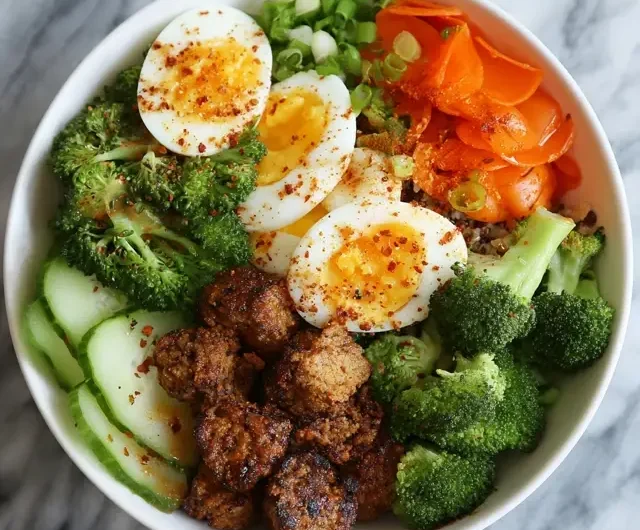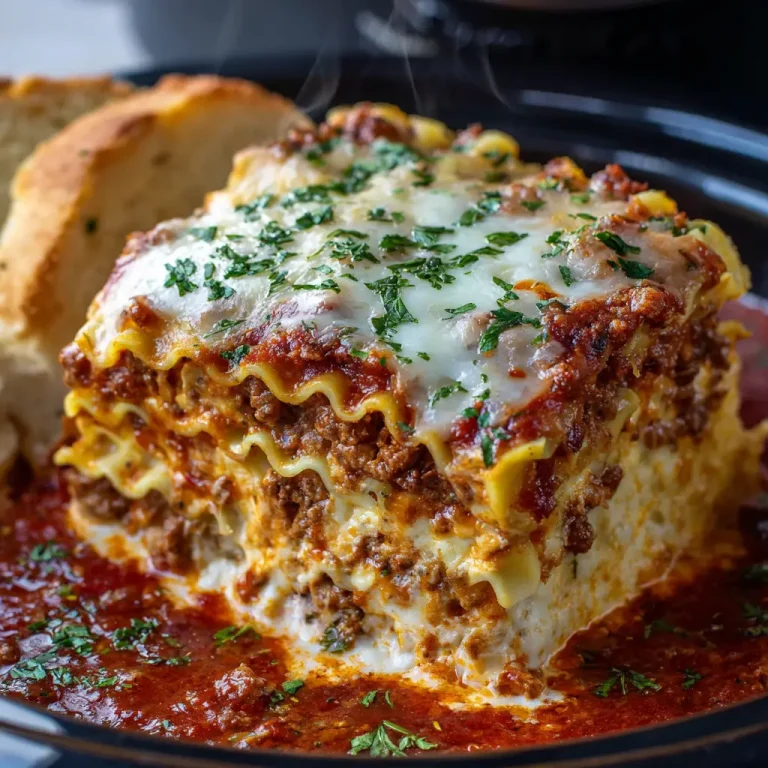Protein Bowls Dinner: Nutritious, Satisfying, and Easy to Make
Introduction
Protein bowls have become a popular choice for dinner among health enthusiasts and busy individuals alike. They provide a complete, well-balanced meal in a single bowl, combining high-quality proteins, fresh vegetables, and wholesome grains. Eating a protein-rich meal in the evening helps to fuel the body, repair muscles, and support metabolism while keeping hunger at bay.
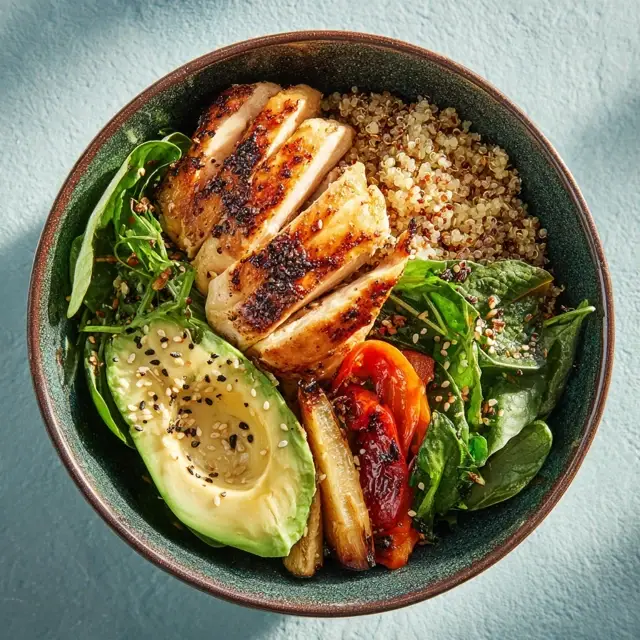
Dinner is often the meal where people feel the need to indulge, yet protein bowls allow for a satisfying, flavorful experience without compromising health goals. They can be colorful, vibrant, and visually appealing, making the act of eating feel joyful and intentional. Preparing a protein bowl for dinner encourages mindful eating, portion control, and the consumption of nutrient-dense ingredients that support energy and well-being.
Ingredients Needed
A classic protein bowl combines lean proteins, complex carbohydrates, and fresh vegetables. Below is a table listing a popular combination of ingredients with approximate calorie counts per serving. Adjust portions based on dietary needs and preferences.
| Ingredient | Quantity | Calories |
|---|---|---|
| Grilled chicken breast | 6 ounces | 280 |
| Quinoa, cooked | 1 cup | 222 |
| Broccoli, steamed | 1 cup | 55 |
| Red bell pepper, sliced | 1 cup | 46 |
| Carrots, shredded | 1 medium | 25 |
| Avocado | 1/2 medium | 120 |
| Olive oil | 1 tablespoon | 119 |
| Lemon juice | 1 tablespoon | 4 |
| Garlic, minced | 1 clove | 4 |
| Salt | 1/4 teaspoon | 0 |
| Black pepper | 1/4 teaspoon | 1 |
| Sesame seeds | 1 teaspoon | 52 |
These ingredients create a balanced bowl with protein, fiber, healthy fats, and essential vitamins and minerals. Grilled chicken provides lean protein that supports muscle repair, while quinoa and vegetables supply complex carbohydrates, fiber, and antioxidants. Healthy fats from avocado and olive oil promote heart health and improve nutrient absorption.
Step-by-Step Cooking Instructions
- Cook the quinoa: Rinse one cup of quinoa under cold water. Combine with two cups of water in a medium saucepan. Bring to a boil, then reduce heat and simmer for fifteen minutes. Remove from heat, cover, and let it sit for five minutes. Fluff with a fork.
- Prepare the vegetables: Steam broccoli until tender but still crisp, about five minutes. Slice the red bell pepper and shred the carrot.
- Cook the protein: Season chicken breast with salt, black pepper, and minced garlic. Heat a grill pan or skillet over medium heat. Cook chicken for six to seven minutes per side or until fully cooked. Let it rest for five minutes before slicing into thin strips.
- Prepare the dressing: In a small bowl, whisk together olive oil and lemon juice. Add a pinch of salt and black pepper. Adjust seasoning to taste.
- Assemble the bowl: Place quinoa at the base of the bowl. Arrange chicken, broccoli, red bell pepper, carrot, and avocado on top. Drizzle dressing evenly over all ingredients. Sprinkle sesame seeds for added texture and flavor.
- Serve: Bowls can be served immediately while warm, or stored in airtight containers for a quick dinner option throughout the week.
Tips for Customizing the Recipe
Protein bowls are highly adaptable to personal taste, dietary needs, and seasonal availability. Swap chicken for grilled salmon, shrimp, or tofu for plant-based protein. Brown rice, farro, or barley can replace quinoa to introduce different flavors and textures. Vegetables can be rotated based on seasonality, including spinach, kale, zucchini, or roasted sweet potatoes.
Dressings can be customized to suit flavor preferences. Options include tahini-based sauces, balsamic vinaigrettes, yogurt herb dressings, or spicy sriracha lime sauce. Nuts and seeds such as almonds, sunflower seeds, or pumpkin seeds can be added for crunch and additional nutrition. Herbs like cilantro, parsley, or basil add freshness without extra calories.
Spices also allow for easy experimentation. Smoked paprika, cumin, turmeric, or chili flakes can elevate the flavor profile. Bowls can be served warm or cold depending on preference, making them versatile for all seasons. Portion sizes can be adjusted to support weight goals or energy needs.
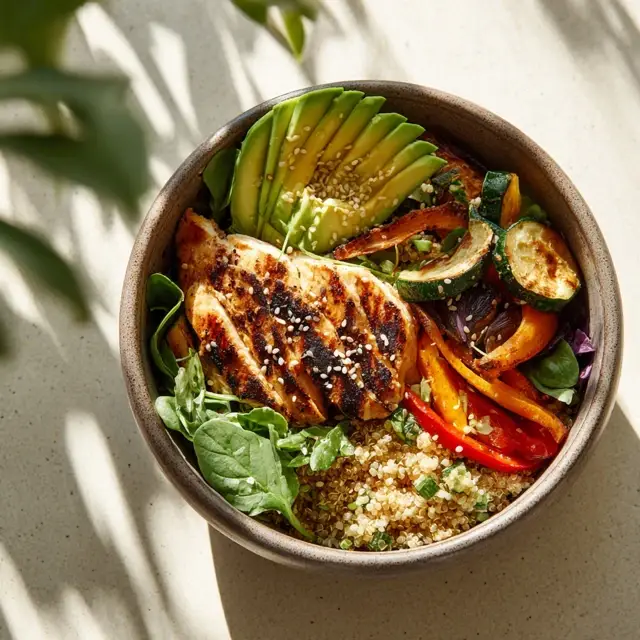
Nutritional Information
A protein bowl prepared with the ingredients above provides a balanced combination of macronutrients and micronutrients. Each serving provides approximately:
- Calories: 932 kcal
- Protein: 46 grams
- Carbohydrates: 78 grams
- Fiber: 15 grams
- Fat: 38 grams
- Vitamins: A, C, K, folate
- Minerals: Iron, magnesium, potassium
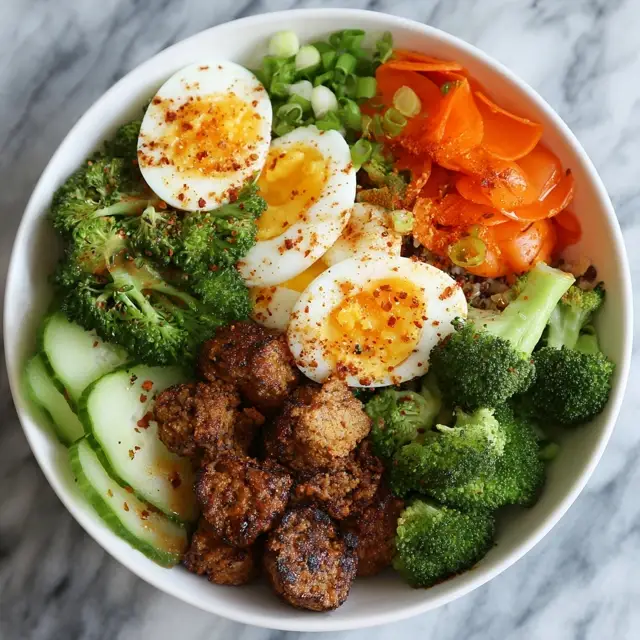
The high protein content supports muscle repair and maintenance, while fiber from vegetables and grains aids digestion. Healthy fats improve satiety and support heart and brain health. Antioxidants from colorful vegetables help fight inflammation and strengthen immunity.
Serving Suggestions
Protein bowls can be served as a complete dinner, paired with light side salads, fresh fruit, or a broth-based soup. Garnish with fresh herbs or a sprinkle of seeds for extra flavor and visual appeal. Bowls can be stored in the refrigerator for up to three days, making them perfect for meal prep.
For a more indulgent option, add roasted sweet potatoes or a dollop of hummus. Bowls can also be transformed into a cold option for warmer months by chilling quinoa and vegetables and using a tangy yogurt or lemon dressing. Serving protein bowls in individual portions helps with portion control and encourages mindful eating.
Protein Bowls Dinner: Nutritious, Satisfying, and Easy to Make
2-3
servings15
minutes20
minutes450-470
kcalIngredients
6 ounces grilled chicken breast
1 cup cooked quinoa
1 cup steamed broccoli
1 cup red bell pepper, sliced
1 medium carrot, shredded
1/2 medium avocado, sliced
1 tablespoon olive oil
1 tablespoon lemon juice
1 clove garlic, minced
1/4 teaspoon salt
1/4 teaspoon black pepper
1 teaspoon sesame seeds
Directions
FAQs
Can I prepare protein bowls in advance?
Yes, cook the protein and grains ahead of time, and store vegetables separately to maintain freshness. Assemble just before serving.
Are protein bowls suitable for vegetarians or vegans?
Absolutely. Replace chicken with tofu, tempeh, chickpeas, or lentils for a plant-based protein source.
How can I reduce calories in a protein bowl?
Reduce the amount of oil, avocado, or grains, and increase vegetables to maintain volume and fullness.
Can I use other grains instead of quinoa?
Yes. Brown rice, farro, barley, or couscous are excellent alternatives.
Is it possible to make protein bowls gluten-free?
Yes. Use naturally gluten-free grains like quinoa or rice, and ensure sauces or dressings do not contain gluten.
Conclusion
Protein bowls for dinner are a simple, nutritious, and satisfying way to enjoy a balanced meal. Combining high-quality proteins, fresh vegetables, wholesome grains, and healthy fats creates a meal that nourishes the body, supports energy levels, and keeps hunger satisfied. The versatility allows for endless combinations, making each dinner exciting, flavorful, and visually appealing.

